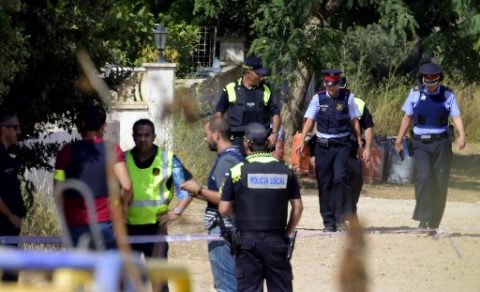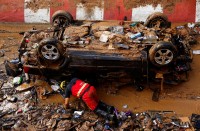
An explosion in a house late on August 16, 2017 in Alcanar, about 200 kilometres (125 miles) south of Barcelona, left one person dead and seven wounded. Initially treated as a random gas blast, police later linked it to the Barcelona assault, believing occupants of the house were preparing an explosive device inside. One of four suspects later arrested was detained in Alcanar.
Drivers have ploughed on August 17, 2017 into pedestrians in two quick-succession, separate attacks in Barcelona and another popular Spanish seaside city, leaving 14 people dead and injuring more than 100 others. / AFP PHOTO / JOSE JORDAN
by Daniel Bosque with Laurence Boutreux in Cambrils
Agence France Presse
BARCELONA, Spain (AFP) — Suspects in Spain’s deadly twin terror attacks were preparing an even bigger assault that was foiled as events unfolded, police said Friday as the death toll rose to 14 with over 100 injured.
Officers also said the driver of the white van which mowed down tourists in the packed centre of Barcelona Thursday evening may have been among suspects killed in the hours since the mayhem started.
Police said they killed five “suspected terrorists” during the night and arrested three others as Spain reeled from the double tragedy in Barcelona and in Cambrils, some 120 kilometres (75 miles) south.
In a poignant moment Friday, Prime Minister Mariano Rajoy, King Felipe VI and the president of Catalonia — where both attacks took place — held a minute of silence in Barcelona. It was followed by applause and shouts of “not afraid”.
In what has been a fast-moving investigation, police were quick to connect the two attacks, and at a briefing Friday afternoon revealed the suspects had apparently been planning something bigger.
“They were preparing one or several attacks in Barcelona and an explosion in Alcanar stopped this as they no longer had the material they needed to commit attacks of an even bigger scope,” said Josep Lluis Trapero of Catalonia’s police.
He was referring to a blast in a house in the town of Alcanar Wednesday evening, which police said killed one person. They said it was caused by an attempt to make explosive devices.
Trapero said that after this, the suspects — who formed part of a cell — allegedly went on to commit “more rudimentary” attacks.
These involved the vehicles ploughing into pedestrians in Barcelona and Cambrils.
The Cambril suspects had an axe and knives in the car as well as fake explosive belts stuck to their bodies, said police.
The police chief added that the driver of the van in Barcelona could be among the five suspects shot dead by security forces in
Cambrils. But while some evidence indicated this, there was no conclusive proof.
– Organised ‘cell’ –
Both the Spanish attacks followed the same modus operandi.
Drivers deliberately targeted pedestrians with their vehicles, just the latest in a series of such assaults in Europe, where cars and vans have been used to lethal effect.
Javier Zaragoza, a prosecutor advising the attorney general in terrorism matters, told AFP the attacks were most likely the work of an organised “cell”.
Otso Iho of Jane’s Terrorism and Insurgency Centre added there appeared to be “a much higher level of coordination than has been typically present in previous attacks”.
As world leaders united in condemning the violence, the Islamic State group propaganda agency Amaq claimed that one of its “soldiers” had carried out the rampage in Barcelona.
It is believed to be the first time IS has claimed an attack in Spain.
– Relatives separated –
In the Barcelona incident, a white van sped down the popular Las Ramblas avenue packed full of tourists Thursday afternoon, knocking people down and killing 13 in a scene of chaos and horror.
The driver left the vehicle on the busy boulevard and fled on foot.
Witnesses described how the van pushed through the crowd, leaving bodies strewn along the boulevard as people fled for their lives, screaming in panic.
“We were on the city tour bus, we were 20 feet from the accident when it happened,” said Alex Luque, a 19-year-old student from New York.
“We heard the van and the impact with people and then we saw people running.”
Then just eight hours later attackers struck again in the early hours of Friday.
This time, the attack was in the seaside resort of Cambrils where an Audi A3 car rammed into pedestrians, injuring six civilians and a police officer. One of the civilians later died.
The police shot dead the five attackers. The also said the had arrested four suspects, including three Moroccans and a Spaniard.
There were at least 34 nationalities among the dead and injured, from countries including Algeria, Australia, China, France, Ireland, Peru and Venezuela, according to Spain’s civil protection agency.
At least two Italians were among the dead, said officials in Rome. At least one American was killed, according to US Secretary of State Rex Tillerson. Belgium said one of its nationals had also died.
– Europe’s deadliest attack –
Spain, the world’s third most popular tourism destination, had until now been spared in the recent wave of extremist attacks that have rocked nearby France, Belgium and Germany.
It had even seen a surge in tourists as visitors fled other restive sunshine destinations like Tunisia and Egypt.
But it is nevertheless no stranger to jihadist attacks.
In March 2004, it was hit by what is still Europe’s deadliest, when bombs on commuter trains in Madrid killed 191 people in an attack claimed by Al Qaeda-inspired extremists.
Spain has also had to deal with a decades-long campaign of violence waged by Basque separatist group ETA, which only declared a ceasefire in 2011.
Police said Thursday that one of the suspects arrested in the Barcelona attack was a Spaniard born in Melilla, a Spanish territory in
North Africa. Another suspect was a Moroccan named as Driss Oukabir.
© Agence France-Presse








